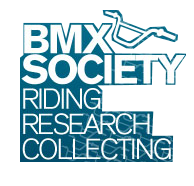
AncientRebel
Users-
Posts
13 -
Joined
-
Last visited
Reputation
0 NeutralAbout AncientRebel
-
Rank
Newbie
Previous Fields
-
Spam Bot Control
Array
Contact Methods
-
ICQ
Array
Recent Profile Visitors
3,258 profile views
-
What is the SE/FMF/Race Inc connection
AncientRebel replied to williwoods's topic in Riding, Research & Collecting
I hope your readers will see my post with a little more insight into these events.- 16 replies
-
- bill bastain
- fmf
-
(and 3 more)
Tagged with:
-
Old school question for the tribal elders
AncientRebel replied to G-flash's topic in Riding, Research & Collecting
As I recall, all of Race, Inc. frames were cerialized with a stamp on one of the rear drop outs. I don't remember which side. Bill used the serial numbers to track which ones were sold under what label, but that was a small part of the business when I was there. Having said that, there were a few rear drop outs that Bill milled himself out of raw aluminum stock. Those were not serialized, but I think the bikes they were used on were not sold as production. The rear dropouts were a frequent failure in early bikes and I think he was testing a different design at the time. -
BMX BOOK on Ebay / Kawasaki Monoshock Bike
AncientRebel replied to BenOr's topic in Riding, Research & Collecting
I never saw anything like this while I was at Triple-A (proper spelling). Reports that it was a nice ride are somehow satisfying, but the thing looks clunky. Note that Yamaha suceeded in the monoshock concept. -
Kawasaki BMX, Race Inc, and Bill Bastian
AncientRebel replied to AncientRebel's topic in Riding, Research & Collecting
-
Kawasaki BMX, Race Inc, and Bill Bastian
AncientRebel replied to AncientRebel's topic in Riding, Research & Collecting
We messed around with a lot of different gussets, but I don't remember this set. Is there a serial number on the frame? -
Brian, I never claimed to know everything about Race. You are right, I did work there for only a short while and don't know everything about the business end of their ventures. I am sadly compelled to respond to your points individually: I never meant to say I welded Kawasakis while working at Race. What I meant to say is that after Bill left Triple-A, he was building his own design and while welding Kawis by day I was building the first few Race bikes by night. My calim taht FMF was a competitor of RAce stands, because I know that we built frames under other flags, and FMF was one of them. There was competition in the market because at first, in my day, FMF was building complete bikes while Race was selling components. That's my understanding. I don't even know waht an RA7 is, so I can't lay claim to any remark about that. I still have never heard of SE racing other than in this comment. So perhaps I'm naive. Finally, I understand that Brian wants to set the record straight, but I stand behind my experiance of the time that I worked there. I don't claim to have the complete RAce, Inc. story, but I was very certainly there in the early days. Thanks for your insights, Brian.
-
Deffinately RAce, Inc. bars. I welded enough of them to know for sure.
-
Kids, I was there. I don't know everything Bill did, but we shared meals and I worked hard for that man. I built Kawasakis and Race, Inc. bikes. I don't want to tear down your image of this time in history, but I have an inside view of the Kawasaki days and the genesis of Race. Please feel free to contact me. I'm mostly harmless.
-
Thanks, Roc. I knew I could count on you.
-
I used to work for Bill in the days surrounding 1976 or so. I don't know anything for sure about GBoy, but I do recall welding up a few bikes that were the same as the Race, Inc. bikes but had a larger forward flange. I do know that Bill sold a lot of frames under a number of different brands. I assume he was liscensing his products to others.
-
I see myself in these pictures. I think the bikes in my days (1970) were slightly more primative, in that we couldn't buy handlebars with cross pieces, but had to weld them in place ourselves. I broke and welded and broke and re-welded many goosenecks. We all had the Stingray frame to work with. We broke frames regularly. Even if the photos are of an era just slightly after mine, they reflect with great accuracy what the first few years of BMX were about: and that was mainly, in my opinion, an expression and realization of freedom and power that kids had never had before. The kids in those pictures are now running things. I hope they have insight into youth that their parents never had. I trust that our learning will be passed on to the next generation.
